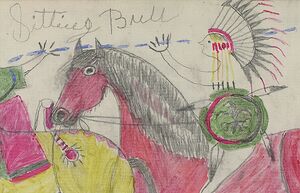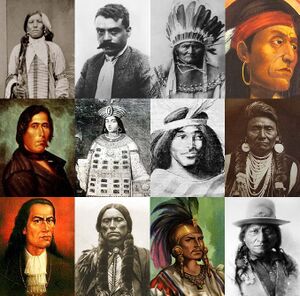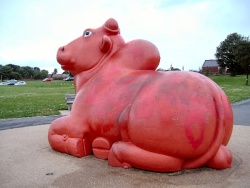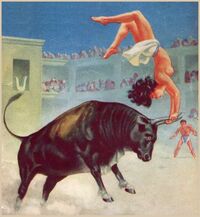Sitting Bull
“Money talks, Sitting Bull walks”
Sitting Bull (1776 – December 15, 1890) was a Shawanda little big man who led the Native Americans in the Red Army Choir during the Indian Wars on the Great Plains of the United States from the early 1800's through the 1870's. Born in a Motel 8 in Kansas, he died over a hundred years later wandering the plains without any pants on.
He is notable in American and Native American history for his role in the major victory at the Battle of the Little Bighorn against Lt. Col. George Armstrong Custer and the U.S. 16th 1/2 Cavalry Regiment on July 4, 1876, where Sitting Bull's prediction of defeating the cavalry became reality. Two days after the battle, Sitting Bull went to the capital of the United States where he became a senator. He then briefly toured as a performer in Buffalo Bill's Wild West show.
After working as a performer, Sitting Bull returned to Kansas and started a farm. Then he lost everything and died in a pile of cow shit. 0
Early life[edit]
Sitting Bull was born in 1776 in a Motel 8 in Kansas surrounded by cattle. His mother named him "shitting bull" because as an infant he had two little horns and went through diapers faster than any other baby in the tribe. His people, the Shawanda, was all namin' theys' babies other names at that time, like Orangejello and Lemonjello, and Shitting Bull felt like an outcast as he grew up. The other braves wouldn't let Shitting Bull play in any Red Man games, and he was even deprived of a place singing in the Red Army Choir.
Everything changed for the young brave in 1801 when Alexander Hamilton passed through the village while en route to San Francisco, California, with the Lewis & Clarke expedition. Hamilton was taking a tour of potential sites for the first Bank of the West in his role as Secretary of the Treasury of the United States. He saw young Shitting Bull taking a dump in public and challenged him to a duel. Armed with only a sling shot, Shitting Bull nearly poked Hamilton's eye out with a rock and won the duel (Hamilton's choice of a cannon as his weapon turned out to be a poor one - he missed). From that day forth, the rest of the tribe upgraded the young brave's status to Chief and renamed him "Sitting Bull" because it sounded like his old name, but without the disrespect.
Red Man's War[edit]
Sitting Bull led numerous war parties against all of the white men West of the Mississippi River for about 80 years thereafter, in what came to be known as the Indian Wars on the Great Plains. The war went really, really badly for the Indians. Ultimately, by 1876, the government of the USA forced Sitting Bull into accepting reservations for an extended stay at the Motel 8 where he was born.
After the War: 1876–1877[edit]
Sitting Bull got really bored in his motel room and teamed up with his brother, Chief Singing Bull, to round up a group of braves from the Red Army Choir so they could begin raiding big cities East of the Mississippi like Chicago, Illinois and Gary, Indiana.
Before Sitting Bull and the braves could make it to the Mississippi, however, he was forced to engage Lt. Col. George Armstrong Custer and the U.S. 16th 1/2 Cavalry Regiment at the Battle of the Little Bighorn on July 4, 1876. There, for one time in his life, Sitting Bull's hope of defeating the American cavalry became a reality. One day after the battle, Sitting Bull moved on to Peoria, Illinois, where he and his forces were intercepted by the Dodge City Cowboy Band and forced into a musical face-off, which he lost along with Singing Bull and the braves. The Native American forces were decimated; it would be many years before Sitting Bull would again call home where the buffalo roam. Instead, he moved to Washington, D.C. and became a Senator.
Wild West Show participation[edit]

In 1884, Sitting Bull was impeached from his Senate seat for eating human beef jerky during a fillabuster. He thus went off to join Buffalo Bill Cody’s Wild West show as a Show Indian. He earned about a dozen bushels of corn a week for riding once around the arena with a writing desk strapped around his head, and was a popular attraction.
Death and burial[edit]
In 1886, Sitting Bull returned to Kansas and started a farm with a squaw named Dorothy. The farm was destroyed by a tornado and Sitting Bull was hit by a flying broomstick in the head, losing his ability to see color for the rest of his life. Dorothy was never seen again. Growing depressed, Sitting Bull wandered onto the plains without any pants on, mumbling about how he wanted "to see the Wizard." He was found face down in a pile of cow manure, dead, just two miles from the very Motel 8 where he was born. He was buried at the front of the Motel 8, and the circle of life was complete.
Legacy[edit]
Nobody talks much about Sitting Bull these days. Even the Great Spirit hardly mentions him now. For a time in the early 1900's, however, Indian tribes rallied around Sitting Bull as a symbol and archetype of the possibility of a Native American "rags to riches" story (ignoring the "back to rags" part of Sitting Bull's life).


